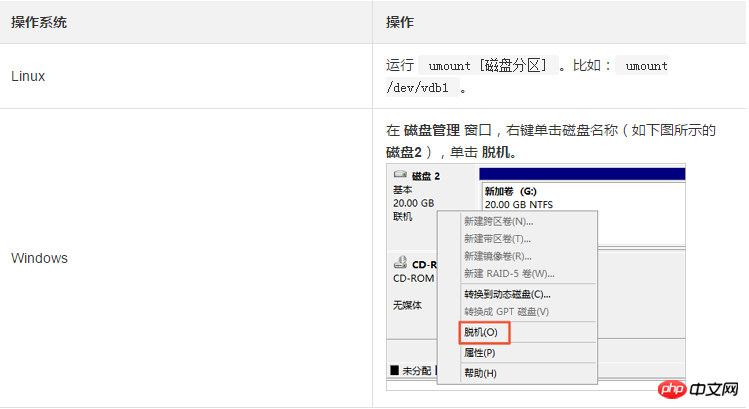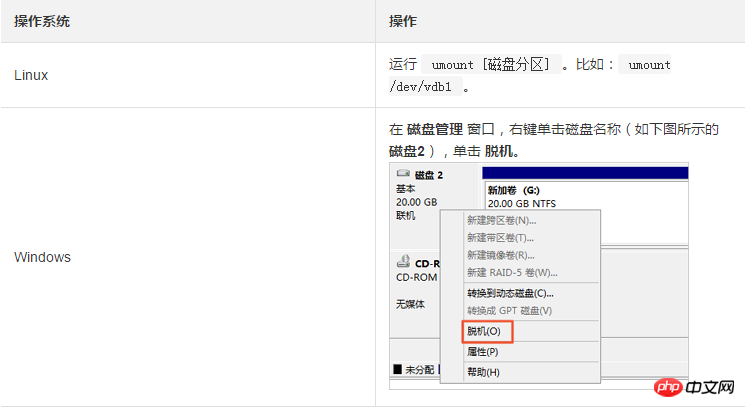 Operation and Maintenance
Operation and Maintenance
 Linux Operation and Maintenance
Linux Operation and Maintenance
 How to uninstall a cloud disk under the Linux operating system and precautions for uninstalling a cloud disk
How to uninstall a cloud disk under the Linux operating system and precautions for uninstalling a cloud disk
How to uninstall a cloud disk under the Linux operating system and precautions for uninstalling a cloud disk
Based on the introduction, this article focuses on how to uninstall the cloud disk and the precautions for uninstalling the cloud disk under the Linux operating system, focusing on the specific operation steps.
Uninstall the cloud disk
When the pay-as-you-go cloud disk is used as a data disk, you can uninstall the cloud disk. However, when the cloud disk is used as the system disk, you cannot unmount the system disk.
When uninstalling a cloud disk, you need to pay attention to the following:
You can only uninstall a pay-as-you-go cloud disk with the status of In Use and the disk attribute of Data Disk.
Cannot unmount local storage.
Under the Windows operating system, you need to pay attention to the following:
In order to ensure data integrity, it is recommended that you suspend read and write operations on all file systems of the disk, otherwise the read and write operations will not be completed. data will be lost.
Before unmounting the cloud disk on the ECS console, you must first remotely connect to the instance and perform offline operations on the disk in Disk Management.
Under the Linux operating system, you need to pay attention to the following:
Before unmounting the cloud disk on the ECS console, you must first remotely connect to the instance and run the umount command to unmount the disk partition.
If you have set up the disk partition in the /etc/fstab file to automatically mount the disk partition when starting the instance, you must first delete the disk partition’s mounting information in the /etc/fstab file before unmounting the cloud disk. , otherwise you will not be able to connect to the instance after it is restarted.
You can uninstall the cloud disk in different ways according to your needs, as shown in the following table.

Uninstall a cloud disk on the instance management page
You can uninstall a cloud disk on the instance management page One or more cloud disks mounted on the instance.
Prerequisite
The cloud disk has been mounted to the instance and the status is in use.
If you are uninstalling a cloud disk on a Linux instance and the disk partition mounting information has been written in the /etc/fstab file, you must first delete this configuration information.
Operation steps
Unmount the cloud disk on the instance management page, follow the steps below:
Connect to the instance remotely, and unmount the disk or partition inside the instance . Depending on the operating system, you need to perform different actions, as shown in the table below.

Log in to the ECS management console.
In the left navigation bar, click Instances.
Select a region.
Find the instance that needs to be operated, click the instance ID, and enter the instance management page.
In the left navigation bar, click this instance disk.
Find the cloud disk that needs to be uninstalled, and in the Action column, select More > Uninstall.
Cloud disks that support uninstallation must have the following attributes:
The disk status must be in use.
Uninstallable must be supported.
Disk attribute must be data disk.
In the pop-up dialog box, click to confirm the uninstallation.
(Optional) If you need to uninstall multiple cloud disks, repeat steps 7 and 8.
When the status of the cloud disk changes to "To be mounted", it means that you have successfully unmounted the cloud disk.
Uninstall a cloud disk on the cloud disk management page
You can uninstall a cloud disk from an instance on the cloud disk management page.
Prerequisite
The cloud disk has been mounted to the instance and the status is in use.
If you are uninstalling a cloud disk on a Linux instance and the disk partition mounting information has been written in the /etc/fstab file, you must first delete this configuration information.
Operation steps
To uninstall the cloud disk on the cloud disk management page, follow the steps below:
Remotely connect to the instance and unmount the disk inside the instance or Partition. Depending on the operating system, you need to perform different actions, as shown in the table below.

Log in to the ECS management console.
In the left navigation bar, select Storage > Cloud Disk.
Select a region.
Find the cloud disk that needs to be uninstalled, and in the Action column, select More > Uninstall.
Cloud disks that support uninstallation must have the following attributes:
The disk status must be in use.
Uninstallable must be supported.
Disk attribute must be data disk.
In the pop-up dialog box, click to confirm the uninstallation.
When the status of the cloud disk changes to "To be mounted", it means that you have successfully unmounted the cloud disk.
Related API
DetachDisk
Follow-up operations
If you no longer need the cloud disk, you can release the cloud disk.
The above is the detailed content of How to uninstall a cloud disk under the Linux operating system and precautions for uninstalling a cloud disk. For more information, please follow other related articles on the PHP Chinese website!

Hot AI Tools

Undresser.AI Undress
AI-powered app for creating realistic nude photos

AI Clothes Remover
Online AI tool for removing clothes from photos.

Undress AI Tool
Undress images for free

Clothoff.io
AI clothes remover

Video Face Swap
Swap faces in any video effortlessly with our completely free AI face swap tool!

Hot Article

Hot Tools

Notepad++7.3.1
Easy-to-use and free code editor

SublimeText3 Chinese version
Chinese version, very easy to use

Zend Studio 13.0.1
Powerful PHP integrated development environment

Dreamweaver CS6
Visual web development tools

SublimeText3 Mac version
God-level code editing software (SublimeText3)

Hot Topics
 What computer configuration is required for vscode
Apr 15, 2025 pm 09:48 PM
What computer configuration is required for vscode
Apr 15, 2025 pm 09:48 PM
VS Code system requirements: Operating system: Windows 10 and above, macOS 10.12 and above, Linux distribution processor: minimum 1.6 GHz, recommended 2.0 GHz and above memory: minimum 512 MB, recommended 4 GB and above storage space: minimum 250 MB, recommended 1 GB and above other requirements: stable network connection, Xorg/Wayland (Linux)
 Linux Architecture: Unveiling the 5 Basic Components
Apr 20, 2025 am 12:04 AM
Linux Architecture: Unveiling the 5 Basic Components
Apr 20, 2025 am 12:04 AM
The five basic components of the Linux system are: 1. Kernel, 2. System library, 3. System utilities, 4. Graphical user interface, 5. Applications. The kernel manages hardware resources, the system library provides precompiled functions, system utilities are used for system management, the GUI provides visual interaction, and applications use these components to implement functions.
 vscode terminal usage tutorial
Apr 15, 2025 pm 10:09 PM
vscode terminal usage tutorial
Apr 15, 2025 pm 10:09 PM
vscode built-in terminal is a development tool that allows running commands and scripts within the editor to simplify the development process. How to use vscode terminal: Open the terminal with the shortcut key (Ctrl/Cmd). Enter a command or run the script. Use hotkeys (such as Ctrl L to clear the terminal). Change the working directory (such as the cd command). Advanced features include debug mode, automatic code snippet completion, and interactive command history.
 How to check the warehouse address of git
Apr 17, 2025 pm 01:54 PM
How to check the warehouse address of git
Apr 17, 2025 pm 01:54 PM
To view the Git repository address, perform the following steps: 1. Open the command line and navigate to the repository directory; 2. Run the "git remote -v" command; 3. View the repository name in the output and its corresponding address.
 How to run java code in notepad
Apr 16, 2025 pm 07:39 PM
How to run java code in notepad
Apr 16, 2025 pm 07:39 PM
Although Notepad cannot run Java code directly, it can be achieved by using other tools: using the command line compiler (javac) to generate a bytecode file (filename.class). Use the Java interpreter (java) to interpret bytecode, execute the code, and output the result.
 Where to write code in vscode
Apr 15, 2025 pm 09:54 PM
Where to write code in vscode
Apr 15, 2025 pm 09:54 PM
Writing code in Visual Studio Code (VSCode) is simple and easy to use. Just install VSCode, create a project, select a language, create a file, write code, save and run it. The advantages of VSCode include cross-platform, free and open source, powerful features, rich extensions, and lightweight and fast.
 What is the main purpose of Linux?
Apr 16, 2025 am 12:19 AM
What is the main purpose of Linux?
Apr 16, 2025 am 12:19 AM
The main uses of Linux include: 1. Server operating system, 2. Embedded system, 3. Desktop operating system, 4. Development and testing environment. Linux excels in these areas, providing stability, security and efficient development tools.
 How to run sublime after writing the code
Apr 16, 2025 am 08:51 AM
How to run sublime after writing the code
Apr 16, 2025 am 08:51 AM
There are six ways to run code in Sublime: through hotkeys, menus, build systems, command lines, set default build systems, and custom build commands, and run individual files/projects by right-clicking on projects/files. The build system availability depends on the installation of Sublime Text.





